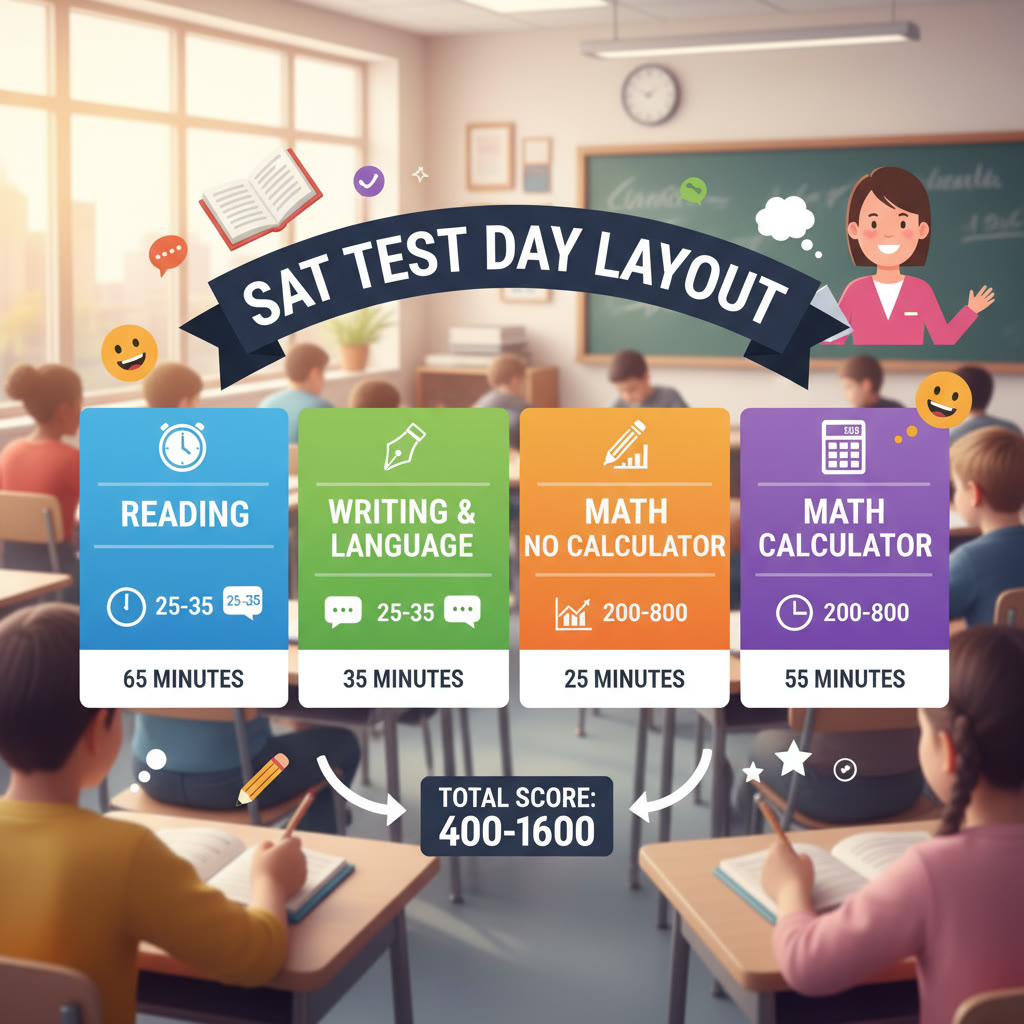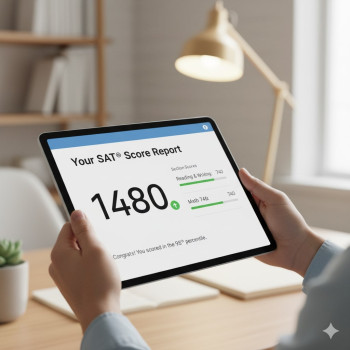What the SAT Measures — A Friendly Detective Story
Think of the SAT as a kind of skill snapshot: it isn’t trying to test everything you know, but it is designed to measure a specific set of academic skills that predict how well you’re likely to do in first-year college courses. That snapshot is useful for admissions officers comparing students from different schools and backgrounds, for scholarship committees, and for you — the student — because it highlights strengths and areas where you can grow.
Why this matters right now
Whether you’re taking the SAT because an application asks for it, or because you want another objective measure to showcase alongside your transcript and activities, understanding what is being measured helps you study smarter, not just harder. The test is structured and predictable; learn the logic and the patterns, and most students can improve significantly.
The big picture: What the SAT looks for
At its core, the SAT measures: reasoning from evidence, command of standard English conventions, fluency with algebra and higher-level math concepts, and the ability to analyze data and real-world scenarios. Here’s that boiled down:
- Reading skills: comprehension, identifying main ideas, interpreting evidence, and recognizing an author’s purpose or tone.
- Writing and language: correcting grammar and usage, tightening expression, and improving the clarity of arguments.
- Mathematics: procedural skill and conceptual understanding across algebra, problem solving with ratios and data, and advanced math topics often summarized as ‘Passport to Advanced Math.’
- Reasoning under time pressure: working accurately and efficiently within focused time blocks.
One more nuance: the essay
The SAT Essay is not part of the standard score used by most colleges anymore. While the optional essay still exists in some contexts, the primary SAT score that admissions teams look at is a 1600-point composite built from the Evidence-Based Reading and Writing section combined with the Math section. Keep an eye on specific college policies, but for most students, focus on the two core sections first.
Section-by-section: What you’ll see on test day
Knowing the structure helps you allocate your practice time effectively. Below is a simple breakdown you can use for practice planning and timing.
| Section | Subsections/Types | Time | Score Range |
|---|---|---|---|
| Evidence-Based Reading | Long and short passages, paired passages, evidence-support questions | 65 minutes | 200–800 (combined with Writing & Language) |
| Writing & Language | Grammar, usage, revision, organization | 35 minutes | 200–800 (combined with Reading) |
| Math (No Calculator) | Algebra, problem solving, heart of algebra, data | 25 minutes | 200–800 (combined with Math—Calculator) |
| Math (Calculator) | Advanced algebra, complex problem solving, some geometry, data analysis | 55 minutes | 200–800 (combined with Math—No Calculator) |
Note: The two Reading/Writing sections combine into one Evidence-Based Reading and Writing (EBRW) score, and the two Math sections combine into a single Math score. These two section scores are then summed into the composite 400–1600 score.
Image idea for this section

Digging into the skills: What each section truly measures
Evidence-Based Reading
This section doesn’t reward memorized trivia or advanced vocabulary used in the eighteenth century. Instead, it measures your ability to read passages carefully and draw supported conclusions. Questions frequently ask you to:
- Identify the main idea or purpose of a passage.
- Interpret vocabulary-in-context — what a word or phrase most likely means given the passage.
- Locate evidence in the passage that supports a previous answer. The test loves pairings: pick an answer about meaning, then pick which sentence shows it.
- Analyze how an author builds an argument or develops characters.
In real-world terms, strong reading skills let you scan complex material efficiently, detect bias, and synthesize information — all critical for college coursework and informed citizenship.
Writing & Language
Think of this section as editing under time pressure. It measures your understanding of standard written English and your ability to improve clarity and argumentation. Typical tasks include:
- Fixing sentence-level grammar and usage errors (pronoun agreement, verb tense, comma misuse).
- Choosing the most concise and precise phrasing.
- Improving paragraph organization and transitions so arguments flow.
These are the kinds of skills instructors expect in essays, lab reports, and presentations — not flashy but essential.
Math: What the SAT’s numbers are testing
The math section is often the most anxiety-producing, but it’s also the most straightforward: the SAT wants to know whether you can apply mathematical concepts to solve problems, often framed in real-world contexts. The emphasis is on:
- Algebra: linear equations, systems, and manipulating expressions.
- Problem solving and data analysis: interpreting graphs, tables, ratios, percentages, and proportional reasoning.
- Advanced math skills: manipulating quadratic or higher-order expressions and interpreting functions (the so-called Passport to Advanced Math).
Two distinct things are being measured here: procedural fluency (can you carry out the math without mistakes?) and conceptual understanding (do you pick the right approach?). The best scorers combine both.
How colleges and others use the SAT score
Admissions: The SAT is one part of a holistic application. Admissions officers use it to compare students from different schools, particularly when curricula and grading can vary widely. A strong SAT score can help an applicant stand out, especially when coupled with a competitive transcript.
Placement and advising: Some colleges use SAT scores to place students into math or writing courses. A higher math score might allow you to skip a remedial course and jump into credit-bearing classes.
Scholarships: Many merit-based awards use a combination of GPA and SAT scores. Improving your score can directly affect scholarship eligibility.
The predictive power of the SAT — what research says
Research shows that the SAT is a reasonably good predictor of first-year college GPA, especially when combined with high school GPA. That’s why admissions teams pay attention: the SAT adds information that grades alone might not capture. It’s not perfect and it isn’t the whole story of you as a student, but it’s a useful, standardized measure when used alongside other application materials.
Limitations and fair use — what the SAT does not measure
The SAT does not measure creativity, persistence, leadership, or the full range of intellectual curiosity. It’s a short, standardized snapshot — so:
- Don’t assume a single test defines your potential. Schools look at extracurriculars, essays, and recommendations too.
- Test anxiety can depress scores, which is why many students benefit from practice under simulated conditions and, in some cases, test-optional policies.
- Socioeconomic factors influence access to prep resources; that’s one reason many students turn to personalized tutoring to level the playing field.
Practical examples: How an SAT question reflects real skills
Example 1 — Reading: A short passage about urban gardening asks what the author’s main argument is and which sentence best supports it. This tests your ability to summarize and find textual evidence — skills used in research projects and class discussions.
Example 2 — Writing & Language: An airline customer service paragraph contains awkward sentences and a pronoun ambiguity. You’re asked to improve clarity and fix grammar. That’s the kind of editing you do every time you proofread a college paper.
Example 3 — Math: A table shows the populations of three towns over time. You’re asked to determine which town’s population grew the fastest as a percentage. You must interpret data, compute percentage change, and choose the correct conclusion — very similar to analyzing trends in a lab or social studies project.
How to prepare — study strategies that actually work
Preparation is two things: improving content knowledge and building test habits. Here’s a reliable plan many students find realistic and effective.
Phase 1: Diagnostic and foundation (Weeks 1–2)
- Take a full-length, timed practice test to identify strengths and weaknesses. Keep this score as your baseline.
- Review errors conceptually — don’t just memorize answers. If you missed algebra questions, drill the underlying algebra concepts.
Phase 2: Targeted practice (Weeks 3–8)
- Build a study schedule with focused blocks: reading practice 3x/week, grammar drills 2x/week, math concepts 4x/week.
- Work on official-style practice questions and time yourself on individual sections.
- Identify common error patterns (rushing, misreading questions, arithmetic mistakes) and design drills to address them.
Phase 3: Simulated testing and fine-tuning (Weeks 9–12)
- Take at least three full-length, timed practice tests under real conditions.
- Focus on pacing strategies: when to skip a question and come back, how much time to spend on grid-ins, and how to use process-of-elimination on reading questions.
- Review the hardest questions thoroughly — these are the ones that typically determine score jumps at the top end.
Study tools and habits
- Short daily practice beats infrequent marathon sessions. Ten to thirty minutes every day reinforces skills better than cramming.
- Practice with official-style questions to get used to the format and phrasing.
- Simulate test-day conditions periodically: same timing, minimal breaks, no distractions.
If you value a highly tailored approach, consider Sparkl’s personalized tutoring: one-on-one guidance can rapidly close gaps, and their tailored study plans (combined with expert tutors and AI-driven insights) help make your practice more efficient and confidence-building. That said, even organized self-study can lead to strong gains if you follow a disciplined plan.
Concrete tips for test day
- Arrive rested and with a light, protein-rich snack for the break. Your concentration depends on sleep and nutrition as much as practice.
- Bring approved ID, pencils, and an approved calculator (and know which calculator rules apply).
- Skim the reading passages strategically: some students prefer reading the questions first, others prefer reading the passage once carefully. Try both in practice to see what fits your brain.
- On math, write down the formula or relation you need before you begin calculations — that reduces careless errors.
- Use process of elimination. Even a partial elimination increases the odds when guessing; there is no penalty for wrong answers, so never leave a question blank.
How improvements translate into opportunities
Jumping a few dozen points can change your applicant profile. For example, moving from the 60th to the 80th percentile can increase scholarship eligibility or strengthen your case for selective programs. That’s why many students invest time and sometimes money into improving their scores — the gains can have tangible effects on application decisions and college finances.
Measuring progress: how to interpret score reports
After each practice or official test, look beyond the composite score. The score report includes section scores, subscores, and a breakdown of question types you missed. Use that to:
- Choose focus areas for the next study block.
- Decide whether you need more content review (e.g., algebra topics) or strategy work (e.g., timing, reading comprehension tactics).
- Track trends over multiple tests — improvement often happens steadily, not overnight.
Quick example of a progress table
| Practice Test | EBRW | Math | Composite |
|---|---|---|---|
| Baseline | 620 | 580 | 1200 |
| Mid-prep | 650 | 640 | 1290 |
| Final practice | 680 | 700 | 1380 |
Notice how steady, targeted work — addressing specific weaknesses — produces measurable gains.
Final thoughts: The SAT is a tool, not a verdict
It’s easy to treat the SAT like a final judgment. Don’t. Think of it as a standardized measure that highlights certain academic skills at a moment in time. Used wisely, it can open doors: strengthen applications, qualify you for scholarships, or place you into classes where you’ll thrive.
Whether you choose to go it alone with a disciplined plan, join a study group, or seek tailored support, the path to a better SAT score is methodical: diagnose, practice deliberately, simulate, and refine. If you decide personalized help is right for you, Sparkl’s personalized tutoring — with one-on-one guidance, tailored study plans, expert tutors, and AI-driven insights — can accelerate that process by ensuring every minute of practice pushes your score in the right direction.
A final encouragement
Preparing for the SAT is also preparation for college work: learning to read analytically, write clearly, and think quantitatively will serve you long after test day. Stay curious, keep practicing with purpose, and remember that your score is a milestone on a larger journey — one that involves growth, discovery, and the next exciting chapter of your education.
Image suggestion for the finale



















No Comments
Leave a comment Cancel